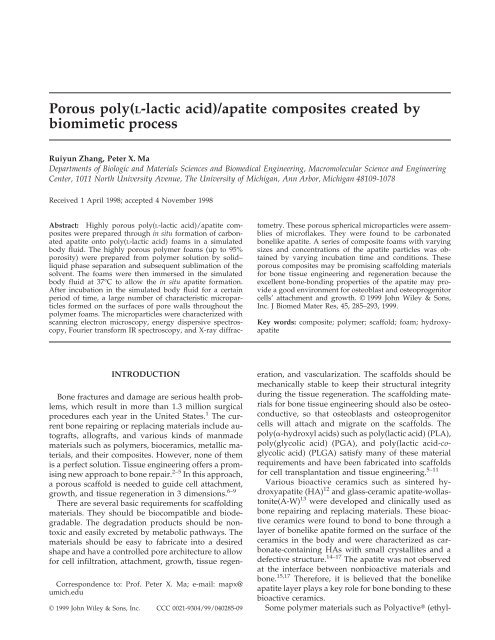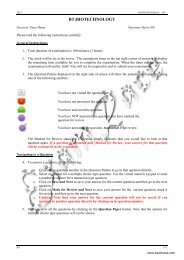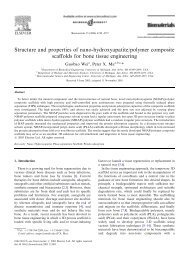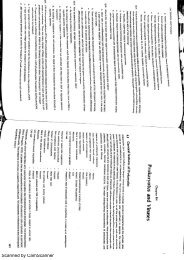You also want an ePaper? Increase the reach of your titles
YUMPU automatically turns print PDFs into web optimized ePapers that Google loves.
Porous poly(L-lactic acid)/apatite composites created by<br />
biomimetic process<br />
Ruiyun <strong>Zhang</strong>, Peter X. Ma<br />
Departments of Biologic and Materials Sciences and Biomedical Engineering, Macromolecular Science and Engineering<br />
Center, 1011 North University Avenue, The University of Michigan, Ann Arbor, Michigan 48109-1078<br />
Received 1 April 1998; accepted 4 November 1998<br />
Abstract: Highly porous poly(L-lactic acid)/apatite composites<br />
were prepared through in situ formation of carbonated<br />
apatite onto poly(L-lactic acid) foams in a simulated<br />
body fluid. The highly porous polymer foams (up to 95%<br />
porosity) were prepared from polymer solution by solid–<br />
liquid phase separation and subsequent sublimation of the<br />
solvent. The foams were then immersed in the simulated<br />
body fluid at 37°C to allow the in situ apatite formation.<br />
After incubation in the simulated body fluid for a certain<br />
period of time, a large number of characteristic microparticles<br />
formed on the surfaces of pore walls throughout the<br />
polymer foams. The microparticles were characterized with<br />
scanning electron microscopy, energy dispersive spectroscopy,<br />
Fourier transform IR spectroscopy, and X-ray diffractometry.<br />
These porous spherical microparticles were assemblies<br />
of microflakes. They were found to be carbonated<br />
bonelike apatite. A series of composite foams with varying<br />
sizes and concentrations of the apatite particles was obtained<br />
by varying incubation time and conditions. These<br />
porous composites may be promising scaffolding materials<br />
for bone tissue engineering and regeneration because the<br />
excellent bone-bonding properties of the apatite may provide<br />
a good environment for osteoblast and osteoprogenitor<br />
cells’ attachment and growth. © <strong>1999</strong> John Wiley & Sons,<br />
Inc. J Biomed Mater Res, 45, 285–293, <strong>1999</strong>.<br />
Key words: composite; polymer; scaffold; foam; hydroxyapatite<br />
INTRODUCTION<br />
Correspondence to: Prof. Peter X. Ma; e-mail: mapx@<br />
umich.edu<br />
© <strong>1999</strong> John Wiley & Sons, Inc. CCC 0021-9304/99/040285-09<br />
Bone fractures and damage are serious health problems,<br />
which result in more than 1.3 million surgical<br />
procedures each year in the United States. 1 The current<br />
bone repairing or replacing materials include autografts,<br />
allografts, and various kinds of manmade<br />
materials such as polymers, bioceramics, metallic materials,<br />
and their composites. However, none of them<br />
is a perfect solution. Tissue engineering offers a promising<br />
new approach to bone repair. 2–5 In this approach,<br />
a porous scaffold is needed to guide cell attachment,<br />
growth, and tissue regeneration in 3 dimensions. 6–9<br />
There are several basic requirements for scaffolding<br />
materials. They should be biocompatible and biodegradable.<br />
The degradation products should be nontoxic<br />
and easily excreted by metabolic pathways. The<br />
materials should be easy to fabricate into a desired<br />
shape and have a controlled pore architecture to allow<br />
for cell infiltration, attachment, growth, tissue regeneration,<br />
and vascularization. The scaffolds should be<br />
mechanically stable to keep their structural integrity<br />
during the tissue regeneration. The scaffolding materials<br />
for bone tissue engineering should also be osteoconductive,<br />
so that osteoblasts and osteoprogenitor<br />
cells will attach and migrate on the scaffolds. The<br />
poly(-hydroxyl acids) such as poly(lactic acid) (PLA),<br />
poly(glycolic acid) (PGA), and poly(lactic acid-coglycolic<br />
acid) (PLGA) satisfy many of these material<br />
requirements and have been fabricated into scaffolds<br />
for cell transplantation and tissue engineering. 5–11<br />
Various bioactive ceramics such as sintered hydroxyapatite<br />
(HA) 12 and glass-ceramic apatite-wollastonite(A-W)<br />
13 were developed and clinically used as<br />
bone repairing and replacing materials. These bioactive<br />
ceramics were found to bond to bone through a<br />
layer of bonelike apatite formed on the surface of the<br />
ceramics in the body and were characterized as carbonate-containing<br />
HAs with small crystallites and a<br />
defective structure. 14–17 The apatite was not observed<br />
at the interface between nonbioactive materials and<br />
bone. 15,17 Therefore, it is believed that the bonelike<br />
apatite layer plays a key role for bone bonding to these<br />
bioactive ceramics.<br />
Some polymer materials such as Polyactive (ethyl-
286 ZHANG AND MA<br />
ene oxide-butylene terephthalate copolymer) were reported<br />
to have the ability to bond to bone. 18 On the<br />
surface of these solid polymers, the formation of bonelike<br />
apatite was also observed after being implanted in<br />
bone. 19 Highly porous poly(-hydroxy acids)/HA<br />
composites were developed previously in our lab. 5 In<br />
this work, highly porous poly(L-lactic acid) (PLLA)<br />
foams were prepared by solid–liquid phase separation<br />
of the polymer solution and subsequent sublimation<br />
of the solvent. The bonelike apatite was grown on the<br />
surfaces of pore walls throughout the PLLA foams in<br />
a simulated body fluid (SBF). The highly porous biodegradable<br />
polymer/apatite composites were created<br />
as a new type of composite scaffold for bone tissue<br />
engineering.<br />
MATERIALS AND METHODS<br />
PLLA with an inherent viscosity of approximately 1.6 was<br />
purchased from Boehringer Ingelheim (Ingelheim, Germany).<br />
There were no free carboxyl end groups on the<br />
PLLA. Dioxane, chloroform, sodium chloride, calcium chloride,<br />
sodium hydrogencarbonate, potassium chloride, potassium<br />
phosphate, magnesium chloride hexahydrate, sodium<br />
sulfate, potassium bromide (for IR spectral specimen preparation),<br />
and synthetic HA [3Ca 3 (PO 4 ) 2 Ca(OH) 2 ] were purchased<br />
from Aldrich (Milwaukee, WI).<br />
Polymer foams and films<br />
The polymer foams were prepared by solid–liquid phase<br />
separation of polymer solutions and subsequent sublimation<br />
of solvent as reported earlier. 5 The polymer was dissolved in<br />
dioxane to make a solution of a desired concentration (from<br />
2.5 to 7.5%). The polymer solution (10 mL) was transferred<br />
into a beaker (30 mL), then the beaker was rapidly transferred<br />
into a refrigerator or a freezer at a present temperature<br />
to solidify the solvent and induce solid–liquid phase<br />
separation. The solidified solution was maintained at that<br />
temperature for 2 h and then immersed in liquid nitrogen to<br />
deep freeze. The frozen mixture was transferred into a<br />
freeze-drying vessel at −5 to −10°C in an ice/salt bath and<br />
then freeze-dried at 0.5 mmHg for 7 days to completely<br />
remove the solvent. Ninety-nine percent of the solvent was<br />
removed in 1 day, and a constant sample weight was<br />
achieved within 4 days. The foam samples were stored in a<br />
desiccator until incubation or characterization.<br />
Solid PLLA films were cast from a 5% PLLA/chloroform<br />
solution on a glass plate at room temperature. Rectangular<br />
specimens with dimensions of 30 mm × 10 mm × 40 m<br />
were obtained.<br />
SBF<br />
An SBF with a modified formulation of the earlier SBF<br />
proposed by Kokubo et al. 20 was prepared by dissolving<br />
reagent grade chemicals of NaCl, NaHCO 3 , KCl,<br />
K 2 HPO 4 3H 2 O, MgCl 2 6H 2 O, CaCl 2 , and Na 2 SO 4 in<br />
deionized water. The inorganic ion concentrations (mM; Na +<br />
213, K + 7.5, Mg 2+ 2.3, Ca 2+ 3.8, Cl − 223, HCO 3 − 27, HPO 4<br />
2−<br />
1.5, SO 4 2− 0.8) were 1.5 times those of human blood plasma.<br />
The fluid was buffered at a pH value of 7.4 at 37°C with<br />
tris-(hydroxymethyl) aminomethane [(CH 2 OH) 3 CNH 2 ] and<br />
hydrochloric acid (HCl). The solution was metastable and<br />
does not precipitate calcium phosphate without external<br />
stimulation.<br />
PLLA incubation in SBF<br />
Five rectangular polymer foam specimens with dimensions<br />
of 12 ×8×6mmwereimmersed in 100 mL SBF in a<br />
glass bottle maintained at 37°C. A series of brief evacuation–<br />
repressurization cycles was performed to force the solution<br />
into the pores of the foams. Cycling was continued until<br />
there were no air bubbles emerging from the foams. The SBF<br />
was renewed every other day. After being incubated for<br />
various periods of time, the specimens were removed from<br />
the fluid and immersed overnight in 100 mL deionized water<br />
to remove the soluble inorganic ions. The solid PLLA<br />
films (30 mm × 10 mm × 40 m) were treated with the same<br />
process in the SBF (five films in 100 mL SBF).<br />
Characterizations<br />
The porosity was determined with a liquid displacement<br />
method reported in detail earlier. 5 Ethanol was chosen as the<br />
displacement liquid because it penetrated easily into the<br />
pores and did not induce shrinkage or swelling as a nonsolvent<br />
of the polymers. A foam sample of weight W was immersed<br />
in a graduated cylinder containing a known volume<br />
(V 1 ) of ethanol. The sample was kept in the ethanol for 5<br />
min, and then a series of brief evacuation–repressurization<br />
cycles was conducted to force the ethanol into the pores of<br />
the foam. Cycling was continued until no air bubbles<br />
emerged from the foam. The total volume of ethanol and the<br />
ethanol-impregnated foam was then recorded as V 2 . The<br />
volume difference, (V 2 − V 1 ), was the volume of the polymer/apatite<br />
composite skeleton of the foam. The ethanolimpregnated<br />
foam was removed from the cylinder, and then<br />
the residual ethanol volume was recorded as V 3 . The quantity<br />
(V 1 − V 3 ), the volume of the ethanol held in the foam,<br />
was determined as the void volume of the foam; thus, the<br />
total volume of the foam was<br />
V =(V 2 − V 1 )+(V 1 − V 3 )=V 2 − V 3 .<br />
The density of the foam, d, was expressed as<br />
d = W/(V 2 − V 3 ),<br />
and the porosity of the foam, , was obtained by<br />
=(V 1 − V 3 )/(V 2 − V 3 ).<br />
The morphology of the incubated polymer foams and<br />
films was studied by scanning electron microscopy (SEM;<br />
S-3200N, Hitachi, Japan) at 15 kV. All SEM micrographs
POROUS POLYMER/APATITE COMPOSITES<br />
287<br />
shown in this article were taken from foams prepared from<br />
a 5% PLLA solution. The specimens were cut into halves<br />
with a razor blade, and the exposed new surfaces were observed<br />
with SEM. For microstructural observation, the specimens<br />
were coated with gold using a sputter coater (Desk-II,<br />
Denton Vacuum Inc.). The gas pressure was less than 50<br />
mTorr and the current was about 40 mA. The coating time<br />
was 200 s. Energy-dispersive spectroscopy (EDS) was also<br />
used to obtain information on the elementary composition of<br />
the particles grown from SBF incubation. For EDS analysis,<br />
the specimens were not coated and the environmental mode<br />
was used.<br />
Fourier transform IR (FTIR) spectra were obtained with a<br />
Nicolet 5-DX FTIR spectrometer with a resolution of 4 cm −1 .<br />
A small amount of powder was scratched from the surface<br />
of an incubated polymer foam or film, then it was milled<br />
with KBr and pressed into a transparent film for IR analysis.<br />
The IR spectrum of the HA was obtained from a commercial<br />
synthetic HA powder from Aldrich.<br />
The X-ray diffraction (XRD) spectra were obtained with a<br />
Rigaku rotating-anode X-ray diffractometer (Rotaflex) at a<br />
2 scan rate of 2.5°/min. Cu K ratiation was used for the<br />
diffraction with a voltage of 40 kV and a current of 100 mA.<br />
The mass increase of the foams during the apatite formation<br />
in the SBF was measured with an analytical balance<br />
accurate to 10 −4 g. The PLLA foams and the PLLA/apatite<br />
composite foams were dried in a fume hood for 1 week and<br />
then vacuum dried at 0.5 mmHg for 24 h before measuring.<br />
The percentage mass increase was normalized with the<br />
foams incubated in a Tris buffer at the same pH (7.4), the<br />
same temperature (37°C), and for the same time intervals<br />
(control samples). Six specimens were measured for each<br />
sample to obtain the averages and standard deviations. The<br />
apatite particle diameter and number density were obtained<br />
from the SEM micrographs of the composite foams. The micrographs<br />
were taken from the typical internal surfaces that<br />
were oriented horizontally. The SEM micrographs were divided<br />
into equal rectangular areas. For each sample, 10 of<br />
these areas that were continuous and horizontally oriented<br />
were selected to calculate the particle density per unit area<br />
(number/100 m 2 ). For each sample, 60 particles were<br />
measured to calculate the average diameter and standard<br />
deviation.<br />
The compressive mechanical testing was conducted with<br />
an Instron 4502 mechanical tester (Instron Co., Canton, MA).<br />
The specimens were circular disks with the same geometry<br />
as a different type of composite sample used previously (∼16<br />
mm in diameter and ∼3 mm in thickness). 5 The crosshead<br />
speed was 0.5 mm/min. The compressive modulus was defined<br />
as the initial linear modulus. Six specimens were tested<br />
for each sample. The averages and standard deviations were<br />
graphed.<br />
A two-tail Student’s t test (assuming equal variances) was<br />
performed to determine the statistical significance (p < 0.05)<br />
of the differences in particle size, density, mass change, and<br />
foam mechanical properties.<br />
RESULTS<br />
The PLLA foams prepared from solid–liquid phase<br />
separation of the PLLA/dioxane solutions were<br />
highly porous and had an open pore structure [Fig.<br />
1(a)]. A porosity of up to 95% was achieved by this<br />
procedure. The porosity of the foam prepared from a<br />
5% PLLA solution was 92.7%. An anisotropic tubular<br />
morphology with an internal ladderlike structure was<br />
obtained. The channels were parallel to the direction<br />
of solidification (heat transfer direction). Each channel<br />
had repeating partitions with uniform spacing perpendicular<br />
to the solidification direction. The diameter<br />
of the channels and the spacing between repeating<br />
partitions in the channels ranging from several tens of<br />
microns to several hundred microns were controlled<br />
by varying the cooling rate and the concentration of<br />
the polymer solution. This characteristic morphology<br />
was attributed to the crystallization of the solvent during<br />
solid–liquid phase separation. 5<br />
The PLLA foams were immersed in the SBF at 37°C<br />
to grow apatite. After 30 days, a large number of microparticles<br />
with a diameter up to 2 m was formed<br />
on the surfaces of the PLLA pore walls (Fig. 1). The<br />
particles were assembled with small flakelike pieces.<br />
Others observed similar morphology of carbonated<br />
HA formed on a silica gel surface after incubating in<br />
SBF. 16 The EDS spectrum showed that the main elements<br />
of the incubated PLLA foam were carbon, oxygen,<br />
calcium, and phosphorus [Fig. 2(a)]. Carbon and<br />
oxygen could be from both PLLA and the particles,<br />
but calcium and phosphorus could only be from the<br />
particles. These results suggested that the particles<br />
formed in the PLLA foams might be similar to HA.<br />
Microparticles were also formed on the solid PLLA<br />
films treated in SBF under the same conditions (Fig. 3).<br />
The particles on the PLLA films were larger than those<br />
in the PLLA foams. The surfaces of the films were<br />
completely covered with the microparticles after 15<br />
days of incubation [Fig. 3(a)]. The morphology of the<br />
formed particles was also a flakelike assembly [Fig.<br />
3(b)]. EDS analysis indicated that calcium and phosphorus<br />
were also the main elements in the particles<br />
[Fig. 2(b)].<br />
Wide-angle XRD was used to characterize the porous<br />
composites. The two strong characteristic peaks<br />
of HA 21 were shown from the apatite powder obtained<br />
from the surface of PLLA films incubated in the<br />
SBF [Fig. 4(a)]. The composite foams [Fig. 4(b, c)]<br />
showed the characteristic peaks of apatites [compare<br />
to Fig. 4(a)] and the characteristic peaks of PLLA 22<br />
[compare to Fig. 4(d)]. The amplitudes of apatite peaks<br />
increased with incubation time in the SBF (in comparison<br />
to PLLA peaks).<br />
FTIR spectroscopy was used to gain more information<br />
on the microparticles formed in the PLLA foams<br />
and on the PLLA films. The spectra of the formed<br />
particles were similar to that of a commercial synthetic<br />
HA (Fig. 5). The characteristic absorption bands of<br />
phosphate in HA appearing at 565, 604, 962, and 1085<br />
cm −1 , which reflect the phosphate vibration mode of<br />
4 , 1 , and 3 , respectively, 23,24 were observed for all
288 ZHANG AND MA<br />
Figure 1. SEM micrographs of a PLLA foam incubated in SBF for 30 days: original magnifications (a) ×100, (b) ×500, (c)<br />
×2000, and (d) ×10,000.<br />
three samples. The spectra of the formed particles [Fig.<br />
5(a, b)] had a strong absorption band at 873 cm −1 corresponding<br />
to the 2 vibration mode of carbonate. The<br />
broad peak around 1640 cm −1 was assigned to the 3<br />
Figure 2. EDS spectra of microparticles from (a) a PLLA<br />
foam incubated in SBF for 30 days and (b) a PLLA film<br />
incubated in SBF for 15 days.<br />
band of carbonate. 25,26 These carbonate peaks from<br />
particles formed from SBF incubation were much<br />
higher than those in commercial synthetic HA. Hydroxyl<br />
stretch was observed at 3570 cm −1 in the spectrum<br />
of commercial synthetic HA [Fig. 5(c)]. However,<br />
no evident peak at the same wave number was observed<br />
for the particles formed from SBF incubation.<br />
The large decrease of the hydroxyl stretch band intensity<br />
and the strong carbonate bands of the microparticles<br />
formed from SBF indicated the carbonate substitution<br />
for OH in HA. 24,26 These results suggested that<br />
the particles in a PLLA foam or on a PLLA film from<br />
SBF incubation were carbonated apatite, which was<br />
similar in composition and structure to the natural<br />
apatite in human and animal hard tissues. The peaks<br />
at 1455 cm −1 ( CH 3 ), 1759 cm −1 ( C=O ), and peaks<br />
ranging from 2870 to 3000 cm −1 ( C−H ) in the spectrum<br />
[Fig. 5(a)] were attributed to the PLLA, which could be<br />
scratched with the apatite particles into the KBr film<br />
prepared for IR analysis.<br />
The variation of the particle number and size in the<br />
PLLA foams was achieved by varying the incubation
POROUS POLYMER/APATITE COMPOSITES<br />
289<br />
Figure 3. SEM micrographs of a PLLA film incubated in SBF for 15 days: original magnifications (a) ×2000 and (b) ×10,000.<br />
time in the SBF (Fig. 6). Almost no apatite microparticles<br />
were observed on the surfaces of the PLLA pore<br />
walls after 3 days of incubation. Scattered and small<br />
microparticles were observed after 6 days of incubation.<br />
After 15 days of incubation, a large number of<br />
apatite microparticles with relatively bigger particle<br />
size was observed. EDS analysis also demonstrated<br />
that the calcium and phosphate contents increased<br />
with incubation time (Fig. 7). As a consequence of particle<br />
growth from the nuclei formed at different times,<br />
there was a wide size distribution. The average particle<br />
diameter, density (number of particles per unit<br />
surface area), and total apatite mass increased with<br />
incubation time (Fig. 8).<br />
Some PLLA foam samples were immersed in distilled<br />
water at 37°C for 15 days before incubation in<br />
SBF for 15 days. There were significantly more apatite<br />
particles formed in the water treated PLLA foams (Fig.<br />
9) than those in the PLLA foams without water treatment<br />
[Fig. 6(d)] for the same SBF incubation time (189<br />
± 32 vs. 25.3 ± 6.8 particles/100 m 2 , p =1.4×10 −13 ).<br />
However, the average diameter of the particles<br />
formed on the water treated foams was significantly<br />
smaller (0.273 ± 0.084 vs. 0.837 ± 0.164 m, p = 3.8 ×<br />
10 −15 ).<br />
The compressive modulus increased with the incubation<br />
time in SBF (Fig. 10). After 30 days or longer,<br />
the compressive modulus became significantly higher<br />
than that of the initial foam (p < 0.05). In contrast, the<br />
compressive modulus of the foams incubated in a Tris<br />
buffer at the same pH (7.4) and temperature (37°C) did<br />
not change significantly within 60 days of incubation<br />
(Fig. 10).<br />
Figure 4. Wide-angle X-ray diffraction spectra of (a) powder<br />
of apatite obtained from the surface of PLLA films incubated<br />
in SBF for 30 days, (b) PLLA foam incubated in SBF<br />
for 30 days, (c) PLLA foam incubated in SBF for 15 days, and<br />
(d) PLLA foam.<br />
Figure 5. FTIR spectra of a commercial HA; the apatite<br />
particles formed from SBF (a) in a PLLA foam, (b) on a PLLA<br />
film, or (c) a commercial HA.
290 ZHANG AND MA<br />
Figure 6. SEM micrographs of a PLLA foam incubated in SBF for (original magnification ×2000) (a) 3 days, (b) 6 days, (c)<br />
10 days, or (d) 15 days.<br />
DISCUSSION<br />
A scaffold for tissue engineering should have a high<br />
porosity and an appropriate pore size. Various techniques,<br />
such as particulate leaching, 6,11 liquid–liquid<br />
phase separation, 27,28 and others, 7,29 have been developed<br />
to fabricate highly porous scaffolds. In this work,<br />
the solid–liquid phase separation of PLLA/dioxane<br />
solution and subsequent sublimation of the dioxane<br />
have been used to obtain highly porous PLLA foams.<br />
The foams have an open pore structure. Varying the<br />
concentration of the polymer solution and phase separation<br />
temperature can control the pore size ranging<br />
from several tens of microns to several hundred mi-<br />
Figure 7. EDS spectra of a<br />
PLLA foam incubated in SBF for<br />
(a) 3 days, (b) 6 days, or (c) 15<br />
days.
POROUS POLYMER/APATITE COMPOSITES<br />
291<br />
Figure 8. The average apatite particle (a) diameter, (b) density,<br />
and (c) total mass percentage increase over PLLA foam<br />
against incubation time in SBF.<br />
crons. 5 A 5% PLLA/dioxane solution has been used in<br />
this study to prepare PLLA foams for in situ apatite<br />
formation because this foam has been well characterized<br />
previously to ensure consistency. 5 However, the<br />
polymer concentration (5%) is not a limiting factor to<br />
this new technology.<br />
Bonelike apatite has been reported to form in the<br />
body on surfaces of various bioactive materials. 13–19,30<br />
The bonelike apatite makes the bioactive material favorable<br />
to bond to bone chemically. The mechanism of<br />
the bonelike apatite formation on CaO−SiO 2 based ceramic<br />
surfaces was proposed as follows 31,32 : the calcium<br />
ions dissolved from the ceramics increased the<br />
ionic activity product of the apatite in the surrounding<br />
body fluid, which was already supersaturated with<br />
respect to apatite; and the hydrated silicon surfaces<br />
provided favorable sites for apatite nucleation. As a<br />
result, a large number of apatite nuclei formed on ceramic<br />
surfaces, grew spontaneously, and consumed<br />
the calcium and phosphate ions from the surrounding<br />
fluid. Based on this mechanism, Kokubo et al. used<br />
CaO−SiO 2 glass particles as a nucleation-inducing<br />
agent. With the induced nucleation and subsequent<br />
incubation in SBF, apatite was grown on several polymer<br />
surfaces, such as polyethylene, poly(ethylene terephthalate),<br />
poly(methyl methacrylate), Nylon-6, and<br />
poly(ether sulfone). 33,34<br />
To create better scaffolds for bone tissue engineering,<br />
porous poly(-hydroxyl acids)/HA composites<br />
were developed by phase separation of poly(hydroxyl<br />
acids)/HA/solvent mixtures and subsequent<br />
solvent sublimation in our laboratory. 5 To our<br />
knowledge, this work is the first successful growth of<br />
apatite on the inner pore surfaces of a porous material.<br />
The apatite particles formed in the PLLA foams incubated<br />
in SBF is similar to the bonelike apatite based on<br />
SEM, EDS, IR, and XRD analyses. For the apatite formation,<br />
the environment that can enhance local calcium<br />
and phosphate ion concentrations may be desirable.<br />
In the SBF, PLLA could be partially hydrolyzed<br />
to generate reasonable numbers of COOH and OH<br />
groups. The weak acidic group COOH may dissociate<br />
partially in the aqueous solution of SBF (pH 7.4) at<br />
37°C, leaving the polymer surface negatively charged.<br />
The calcium and phosphate ions may be accumulated<br />
by COO − , COOH, and OH groups through electrostatic<br />
force and hydrogen bonding. The local increase<br />
of supersaturation of calcium and phosphate ions<br />
makes the nucleation of apatite possible. The hydrolysis<br />
of the PLLA is a slow process and the degree of<br />
the hydrolysis is time dependent. With increasing incubation<br />
time, the COOH and OH groups increase,<br />
which leads to the increased apatite nucleation rate.<br />
In order to test whether the polymer hydrolysis is<br />
important in the apatite nucleation, PLLA foam<br />
samples were immersed in distilled water at 37°C for<br />
15 days before incubation in SBF. The number of apatite<br />
particles formed in the water treated PLLA foams<br />
was significantly larger (189 vs. 29.3/100 m 2 ) while<br />
the average particle diameter was significantly smaller<br />
(0.273 vs. 0.837 m) than those in the PLA foams without<br />
water treatment for the same SBF incubation time.<br />
The hydrated groups such as COOH and OH from the<br />
PLLA hydrolysis may contribute to the higher apatite
292 ZHANG AND MA<br />
Figure 9. SEM micrographs of a PLLA foam immersed in H 2 O (at 37°C) for 15 days and then incubated in SBF for 15 days:<br />
original magnifications (a) ×2000 and (b) ×10,000.<br />
nucleation rate in the water treated PLLA foams. The<br />
higher number of initial nucleation sites may compete<br />
with each other for the calcium and phosphate ions,<br />
thus leading to the smaller average size. This result<br />
indicates that the hydrolysis of PLLA may have<br />
played an important role during the apatite formation<br />
in the PLLA foams, which corroborates our hypothesis.<br />
The solid PLLA films were completely covered with<br />
apatite particles in a relatively short incubation time.<br />
Much larger apatite particles were formed on the<br />
PLLA films than in PLLA foams with the same incubation<br />
time, which was presumably due to a much<br />
smaller surface area on the solid films, leading to a<br />
higher degree of supersaturation with respect to the<br />
small number of nucleation sites and a fast apatite<br />
particle size growth.<br />
The compressive modulus of the PLLA/apatite<br />
foams was higher than that of the initial PLLA foam.<br />
This indicated that the apatite particles enhanced the<br />
mechanical properties of the foams. The compressive<br />
modulus of the foams incubated in a Tris buffer at the<br />
same conditions within 60 days had no significant<br />
change compared to the initial foam. It seems that the<br />
molecular weight decrease within this time frame was<br />
not large enough to cause mechanical property deterioration.<br />
This was presumably due to the slow hydrolysis<br />
rate of the hydrophobic PLLA.<br />
This work demonstrated how the biomimetic process<br />
of in situ apatite formation from an SBF can be<br />
used to fabricate porous biodegradable polymer/<br />
apatite composites. Although the PLLA foams were<br />
created with a solid–liquid phase separation technique<br />
in this work, the method could be utilized to grow<br />
apatite for other porous polymeric or nonpolymeric<br />
materials as long as they have an open pore structure<br />
to allow SBF penetration.<br />
CONCLUSIONS<br />
Figure 10. Compressive modulus against incubation time<br />
at 37°C in () the SBF and () a Tris buffer at pH 7.4.<br />
Highly porous PLLA foams with a ladderlike porous<br />
structure were prepared from phase separation<br />
of the polymer solutions and subsequent solvent sublimation.<br />
New porous PLLA/apatite composites were<br />
created by incubating the polymer foams in the SBF. A<br />
large number of apatite microparticles was formed in<br />
situ on the surfaces of pore walls throughout the PLLA<br />
foams. Based on SEM, EDS, XRD, and FTIR analyses,<br />
the apatite particles were similar to the apatite in natural<br />
bone. These apatite particles were characteristic porous<br />
spheres assembled with small flakes. The apatite<br />
particles were formed through a nucleation phase and<br />
a growth phase. The particle number and size were<br />
determined by several factors such as incubation time,<br />
ionic concentration of the SBF, water treatment, and<br />
the polymer surface area. The compressive modulus
POROUS POLYMER/APATITE COMPOSITES<br />
293<br />
increased with incubation time in the SBF. The excellent<br />
bone-bonding property of the bonelike apatite<br />
may provide a good environment for the attachment<br />
and growth of osteoblasts and osteoprogenitor cells.<br />
References<br />
1. Langer R, Vacanti J. Tissue engineering. Science 1993;260<br />
(5110):920–926.<br />
2. Vacanti CA, Vacanti JP. Bone and cartilage reconstruction. In:<br />
Lanza RP, Langer R, Chick WL, editors. Principles of tissue<br />
engineering. Austin, TX: R. G. Landes Company; 1997. p 619–<br />
631.<br />
3. Crane G, Ishaug S, Mikos A. Bone tissue engineering. Nat Med<br />
1995;1:1322–1324.<br />
4. Vacanti C, Vacanti J. Bone and cartilage reconstruction with<br />
tissue engineering approaches. Otolaryngol Clin North Am<br />
1994;27(1):263–276.<br />
5. <strong>Zhang</strong> R, Ma PX. Poly(-hydroxy acids)/hydroxyapatite porous<br />
composites for bone tissue engineering. I. Preparation and<br />
morphology. J Biomed Mater Res <strong>1999</strong>;44:446–455.<br />
6. Ma PX, Langer R. Fabrication of biodegradable polymer foams<br />
for cell transplantation and tissue engineering. In: Yarmush M,<br />
Morgan J, editors. Tissue engineering methods and protocols.<br />
Totowa, NJ: Humana Press Inc.; 1998.<br />
7. Ma PX, Langer R. Degradation, structure and properties of<br />
fibrous nonwoven poly(glycolic acid) scaffolds for tissue engineering.<br />
In: Mikos AG, Leong KW, Yaszemski MJ, Tamada JA,<br />
Radomsky ML, editors. Polymers in medicine and pharmacy.<br />
Pittsburgh, PA: MRS; 1995. p 99–104.<br />
8. Ma PX, Schloo B, Mooney D, Langer R. Development of biomechanical<br />
properties and morphogenesis of in vitro tissue engineered<br />
cartilage. J Biomed Mater Res 1995;29:1587–1595.<br />
9. Ma PX, Shin’oka T, Zhou T, Shum–Tim D, Lien J, Vacanti JP,<br />
Mayer J, Langer R. Biodegradable woven/nonwoven composite<br />
scaffolds for pulmonary artery engineering in an juvenile<br />
lamb model. Trans Soc Biomater 1997;20:295.<br />
10. Ma PX, Langer R. Morphology and mechanical function of<br />
long-term in vitro engineered cartilage. J Biomed Mater Res<br />
<strong>1999</strong>;44:217–221.<br />
11. Mikos AG, Thorsen AJ, Czerwonka LA, Bao Y, Langer R, Winslow<br />
DN, Vacanti JP. Preparation and characterization of<br />
poly(L-lactic acid) foams. Polymer 1994;35:1068–1077.<br />
12. Jarcho M. Retrospective analysis of hydroxyapatite development<br />
for oral implant applications. Dent Clin North Am 1992;<br />
36:19–26.<br />
13. Kokubo T, Shigematsu M, Nagashima Y, Tashiro M, Yamamuro<br />
T, Higashi S. Apatite- and wollastonite-containing glassceramics<br />
for prosthetic application. Bull Inst Chem Res Kyoto<br />
Univ 1982;60:260–268.<br />
14. Hench LL. Bioactive ceramics. Ann New York Acad Sci 1988;<br />
523:54–71.<br />
15. Kitsugi T, Yamamuro T, Nakamura T, Kokubo T. Bone bonding<br />
behavior of MgO−CaO−SiO 2 −P 2 O 5 −CaF 2 glass (mother<br />
glass of AW-glass-ceramics). Biomed Mater Res 1989;23:631–<br />
648.<br />
16. Li P, Nakanishi K, Kokubo T, de Groot K. Induction and morphology<br />
of hydroxyapatite, precipitated from metastable simulated<br />
body fluids on sol-gel prepared silica. Biomaterials 1993;<br />
14:963–968.<br />
17. Kitsugi T, Yamamuro T, Nakamura T, Kokubo T. The bonding<br />
of glass ceramics to bone. Int Orthop (SICOT) 1989;13:199–206.<br />
18. van Blitterswijk CA, Bakker D, Leenders H, Blink Jvd, Hesseling<br />
SC, Bovell YP, Radder AM, Sakkers RJ, Gaillard ML,<br />
Heinze PH, Beumer GJ. Interfacial reactions leading to bone<br />
bonding with PEO/PBT copolymers (Polyactive). In: Ducheyne<br />
P, Kokubo T, van Blitterswijk CA, editors. Bonebonding<br />
biomaterials. Leiderdrop: Reed Healthcare Communication;<br />
1992. p 13–30.<br />
19. Li P, Bakker D, van Blitterswijk CA. The bone-bonding polymer<br />
Polyactive 80/20 induces hydroxycarbonate apatite formation<br />
in vitro. J Biomed Mater Res 1997;34:79–86.<br />
20. Kokubo T, Kushitani H, Sakka S, Kitsugi T, Yamamuro T. Solutions<br />
able to reproduce in vivo surface-structure changes in<br />
bioactive glass-ceramic A-W. J Biomed Mater Res 1990;24:721–<br />
734.<br />
21. Aoki H. Science and medical applications of hydroxyapatite.<br />
Tokyo: Jaas; 1991. p vii, xv, 214.<br />
22. Brizzolara D, Cantow HJ, Diederichs K, Keller E, Domb AJ.<br />
Mechanism of the stereocomplex formation between enantiomeric<br />
poly(lactide)s. Macromolecules 1996;29:191–197.<br />
23. Fowler BO. Infrared study of apatite. Inorg Chem 1974;13:194–<br />
214.<br />
24. Rehman I, Bonfield W. Characterization of hydroxyapatite and<br />
carbonated apatite by photo acoustic FTIR spectroscopy. J<br />
Mater Sci Mater Med 1997;8:1–4.<br />
25. El Feki H, Rey C, Vignoles M. Carbonate ions in apatite, infrared<br />
investigation in r CO 3 domain. Calcif Tissue Int 1991;49:<br />
269–274.<br />
26. Elliott JC, Holcomb DW, Young RA. Infrared determination of<br />
the degree of substitution of hydroxyl by carbonate ions in<br />
human dental enamel. Calcif Tissue Int 1985;37:372–375.<br />
27. Schugens C, Maquet V, Grandfils C, Jerome R, Teyssie P. Polylactide<br />
macroporous biodegradable implants for cell transplantation.<br />
II. Preparation of polylactide foams by liquid–liquid<br />
phase separation. J Biomed Mater Res 1996;30:449–461.<br />
28. Lo H, Ponticiello MS, Leong KW. Fabrication of controlled<br />
release biodegradable foams by phase separation. Tissue Eng<br />
1995;1:15–28.<br />
29. Wintermantel E, Mayer J, Blum J, Eckert KL, Luscher P,<br />
Mathey M. Tissue engineering scaffolds using superstructures.<br />
Biomaterials 1996;17:83–91.<br />
30. Jarcho M, Kay JF, Gumaer KI, Doremus RH, Drobeck HP. Tissue,<br />
cellular and subcellular events at a bone–ceramic hydroxylapatite<br />
interface. J Bioeng 1977;1:79–92.<br />
31. Ohtsuki C, Kokubo T, Yamamuro T. Mechanism of apatite<br />
formation on CaO−SiO 2 −P 2 O 5 glasses in a simulated body<br />
fluid. J Non-Cryst Solids 1992;143:84–92.<br />
32. Li P, Ohtsuki C, Kokubo T, Nakanishi K, Soga N, Nakamura T,<br />
Yamamuro T. Apatite formation induced by silica gel in a<br />
simulated body fluid. J Am Ceram Soc 1992;75:2094–2097.<br />
33. Kokubo T, Hata K, Nakamura T, Yamamuro T. Apatite formation<br />
on ceramics, metals and polymers induced by a<br />
CaO−SiO 2 -based glass in a simulated body fluid. In: Bonfield<br />
W, Hastings GW, Tunner KE, editors. Bioceramics. Guiford,<br />
UK: Butterworth–Heinemann; 1991. p 113–120.<br />
34. Tanahashi M, Yao T, Kokubo T, Minoda M, Miyamoto T, Nakamura<br />
T, Yamamuro T. Apatite coating on organic polymers<br />
by a biomimetic process. J Am Ceram Soc 1994;77:2805–2808.











